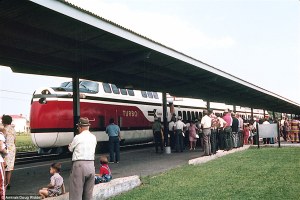New York’s Transit Museum is in the former Court Street station on the corner of Boerum Place and Schermerhorn Street in Downtown Brooklyn.
The station opened in 1936, but closed 10 years later because it wasn’t used enough, explained Regina Asborno, director of the museum. There were plans at the time to eventually connect the station to the Second Avenue line in Manhattan, but that never happened.
Since the museum is inside a former station, the entrance is just like any other entrance to a below-ground subway station. There is also a handicap-accessible entrance, but this is the main entrance.
In 2015, the museum had a record year with 170,000 visitors,
There was a shuttle train that operated at Court Street, but it only brought passengers to one other station about three blocks away, so it wasn’t necessary to keep. It was turned into a museum in the summer of 1976.
The first exhibit in the museum is called “Steel, Stone, and Backbone: Building New York’s Subways, 1900-1925.” It takes visitors through the stages of building the subways. Asborno said many of the pictures they have of the construction were taken for insurance purposes at the time. Since the construction was quite dangerous and could potentially affect the buildings above ground, photographers were hired to take pictures along the routes of the first tunnels, she explained.
On the original platform and tracks of the station, the museum features vintage trains that were used starting in 1904. The train doors are open so people can go inside.
Asborno said there are also vintage buses, but they are too large to be shown at the museum. They are kept in various MTA bus depots and brought out for special occasions, such as the annual Bus Festival in September.
Take a step back to 1904 by walking through the oldest trains at the museum. The trains were used on the elevated tracks at the time, Asborno said. They are made of wood, which makes them lighter and more functional on elevated tracks but not practical for underground tracks.
These trains only had doors at either end of the cars, and at each stop, the gates had to be manually opened by an operator on each car. The operators communicated with the conductor using bells on each car to let him know he could start the train again.
The term straphangers, used to describe commuters, comes from the straps that hung from the top of these original cars.

Advertisements have always been a part of the subway system. While the ads on each of the cars are replicas of originals, they give visitors an idea of the time period. Asborno said trains have a 40- to 60-year life span, so the ads would have changed many times in each of the cars.
A 10-car trial train was built in 1949 in anticipation of the Second Avenue subway line. Each car cost $100,000 to build, which is how it got its name, The Million Dollar Train. At the time, “The New York Times” deemed it the “car of tomorrow” because of its modern look, including new fluorescent lighting. But the train was never in full operation, as the Second Avenue line has yet to be built, and the cars were redesigned to operate with existing trains.
The newest car in the exhibit is just like many that run today. Asborno said this car is a favorite for kids because they usually aren’t allowed to explore the cars when they ride the subway. It’s also used for programs to help people with social or intellectual disabilities learn social skills to help them ride the subways, Asborno said.
 Remember when the subway fare was only 15 cents? Neither do we, but you can see what the turnstiles looked like when it was that cheap. The earliest turnstile from 1904 didn’t even have a spot for coins, tokens or cards. Commuters would buy their tickets, hand them to an operator and the operator would allow them through the turnstile by pressing a pedal.
Remember when the subway fare was only 15 cents? Neither do we, but you can see what the turnstiles looked like when it was that cheap. The earliest turnstile from 1904 didn’t even have a spot for coins, tokens or cards. Commuters would buy their tickets, hand them to an operator and the operator would allow them through the turnstile by pressing a pedal.
The “Bringing Back the City: Mass Transit Responds to Crisis” exhibit gives visitors a behind-the-scenes look at how the MTA operates. There are first-hand experiences from MTA employees about the attacks on 9/11, the 2003 Northeast Blackout, the Blizzard of 2010, Hurricane Irene and superstorm Sandy. Asborno said people often don’t realize how many different jobs there are in the MTA, which employs over 60,000 people.
The Transit Museum is open Tuesday through Sunday. Admission is $7 for adults and $5 for children and senior citizens.
By Nicole Brown
























